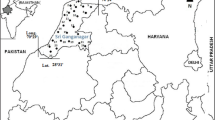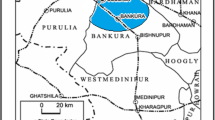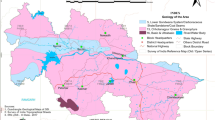Abstract
A screening survey has been carried out to measure the radon concentration in drinking water at various locations of Ajodhya hill and surrounding areas in Purulia district of West Bengal, India, using AlphaGUARD radon monitor. The obtained 222Rn concentration in ground water varies from 5.71 ± 0.29 to 579.47 ± 23.18 Bq/l with an average of 110.00 ± 6.61 Bq/l. Comparison between our results with the internationally recommended reference levels reveals that drinking of water from the majority of these tube-wells can pose significant health risks to the local people. Correlation study indicates that tube-well depth has significant influence on the radon level in water samples. Using 60 l/yr and 1642.50 l/yr water consumption estimated annual effective radon doses for most of the samples (almost 70% and 96%, respectively) are high compared to the World Health Organization (WHO) and the European Union (EU) Commission prescribed reference dose limit of 100 μSv/yr. Also, the evaluated Excess Lifetime Cancer Risk (ELCR) values associated with the tube-wells are showing serious threat to the health of the locals.
The primary goal of this work is to develop a radon profile map of this area and to find out the possible reasons behind the elevated radon level in ground water. This type of work may play a very crucial role to aware the locals in perspective of human exposure to radon. The local health officials and the water quality regulators of India are requested to take necessary steps for protecting the local people from water radon hazard.








Similar content being viewed by others
References
Abdallah, S. M., Habib, R. R., Nuwayhid, R. Y., Chatila, M., & Katul, G. (2007). Radon measurements in well and spring water in Lebanon. Radiation Measurements, 42(2), 298–303. https://doi.org/10.1016/j.radmeas.2006.11.004
Acharya, T., & Nag, S. K. (2013). Study of groundwater prospects of the crystalline rocks in Purulia District, West Bengal, India using remote sensing data. Earth Resources, 1(2), 54–59. https://doi.org/10.12966/er.07.03.2013
Ademola, J. A., & Ojeniran, O. R. (2017). Radon-222 from different sources of water and the assessment of health hazard. Journal of Water and Health, 15(1), 97–102. https://doi.org/10.2166/wh.2016.073
Amrani, D. (2002). Natural radioactivity in Algerian bottled mineral waters. Journal of Radioanalytical and Nuclear Chemistry, 252(3), 597–600. https://doi.org/10.1023/A:1015883610854
Andrews, J. N., & Wood, D. F. (1972). Mechanism of radon release in rock matrices and entry into groundwaters. Bath Univ. of Tech Eng., 81, 198–209.
Baidya, T. K. (1992). Apatite-magnetite deposit in the Chhotanagpur gneissic complex, Panrkidh area, Purulia district. West Bengal. Indian J. Geol., 64, 84–95.
Bem, H., Plota, U., Staniszewska, M., Bem, E. M., & Mazurek, D. (2014). Radon (222Rn) in underground drinking water supplies of the Southern Greater Poland Region. Journal of Radioanalytical and Nuclear Chemistry, 299(3), 1307–1312. https://doi.org/10.1007/s10967-013-2912-1
Benesty, J., Chen, J., Huang, Y., & Cohen, I. (2009). Pearson correlation coefficient. Noise reduction in speech processing (Vol. 2, pp. 1–4). Berlin, Heidelberg: Springer.
Bhaya, S., Chakrabarty, A. (2016). Application of geoinformatics in pattern analysis of seditious activity in Purulia district of West Bengal in relation to it’s geographic and socio-economic background. Int J Sci Res Publ, 6(9). http://www.ijsrp.org/research-paper-0916.php?rp=P575816
Binesh, A., Mowlavi, A. A., & Mohammadi, S. (2012). Estimation of the effective dose from radon ingestion and inhalation in drinking water sources of Mashhad, Iran. Iran Journal of Radiation Research., 10(1), 37–41.
BIS (2012). Indian standard drinking water — specification (Second Revision) IS 10500; 2012. ICS 13.060.20. May 20125. © BIS 2012. http://cgwb.gov.in/documents/wq-standards.pdf
Bourai, A. A., Gusain, G. S., Rautela, B. S., Joshi, V., Prasad, G., & Ramola, R. C. (2012). Variations in radon concentration in groundwater of Kumaon Himalaya. India. Radiation Protection Dosimetry, 152(1–3), 55–57. https://doi.org/10.1093/rpd/ncs186
Brutsaert, W. F., Norton, S. A., Hess, C. T., & Williams, J. S. (1981). Geologic and hydrologic factors controlling radon-222 in ground water in Maine. Groundwater, 19(4), 407–417. https://doi.org/10.1111/j.1745-6584.1981.tb03488.x
Charoensri, A., Siriboonprapob, S., & Sastri, N. (2015). Analysis of radon in shallow-well water: a case study at Phichit subdistrict in Songkhla province, Thailand. In Journal of Physics: Conference Series., 611(1), 012025. https://doi.org/10.1088/1742-6596/611/1/012025
Choubey, V. M., Bartarya, S. K., & Ramola, R. C. (2003). Radon in groundwater of eastern Doon valley. Outer Himalaya. Radiation Measurements, 36(1–6), 401–405. https://doi.org/10.1016/S1350-4487(03)00160-4
Choubey, V. M., & Ramola, R. C. (1997). Correlation between geology and radon levels in groundwater, soil and indoor air in Bhilangana Valley, Garhwal Himalaya, India. Environmental Geology, 32(4), 258–262. https://doi.org/10.1007/s002540050215
Clever, H. L. (1985). Temperature dependency of the diffusion coefficient ‘k.’ Solubility data series, Krypton, Xenon, Radon Gas Solubilities 2 (pp. 463–468). Pergamon Press.
Council Directive 2013/51/EURATOM, (2013). Laying down requirements for the protection of the health of the general public with regard to radioactive substances in water intended for human consumption. Official Journal of the European Union L (296):12–21.
D’Cunha, P., Narayana, Y., Karunakara, N., Yashodhara, I., & Kumara, S. (2011). Concentration of 222 Rn in drinking water along coastal Kerala and evaluation of ingestion doses. Radiation Protection and Environment, 34(3), 197. https://doi.org/10.4103/0972-0464.101722
Dietrich, A. M., & Burlingame, G. A. (2015). Critical review and rethinking of USEPA secondary standards for maintaining organoleptic quality of drinking water. Environmental Science & Technology, 49(2), 708–720. https://doi.org/10.1021/es504403t
Dixon, W. J., & Massey, F. J., Jr. (1951). Introduction to statistical analysis. McGraw-Hill.
Duggal, V., Sharma, S., & Mehra, R. (2017). Radon levels in drinking water of Fatehabad district of Haryana, India. Applied Radiation and Isotopes, 123, 36–40. https://doi.org/10.1016/j.apradiso.2017.02.028
Duggal, V., Sharma, S., & Mehra, R. (2020). Risk assessment of radon in drinking water in Khetri Copper Belt of Rajasthan, India. Chemosphere, 239, 124782. https://doi.org/10.1016/j.chemosphere.2019.124782
El-Araby, E. H., Soliman, H. A., & Abo-Elmagd, M. (2019). Measurement of radon levels in water and the associated health hazards in Jazan, Saudi Arabia. Journal of Radiation Research and Applied Sciences, 12(1), 31–36. https://doi.org/10.1080/16878507.2019.1594134
EU. (2001). Recommendation on the protection of the public against exposure to radon in drinking water supplies. Office Journal of the European Community, 85–88.
Folger, P. F., Nyberg, P., Wanty, R. B., & Poeter, E. (1994). Relationships between 222Rn dissolved in ground water supplies and indoor 222Rn concentrations in some Colorado front range houses. Health Physics, 67(3), 245–253.
Fonollosa, E., Peñalver, A., Borrull, F., & Aguilar, C. (2016). Radon in spring waters in the south of Catalonia. Journal of Environmental Radioactivity, 151, 275–281.
Fraser, D. F., Gilliam, J. F., Daley, M. J., Le, A. N., & Skalski, G. T. (2001). Explaining leptokurtic movement distributions: Intrapopulation variation in boldness and exploration. The American Naturalist, 158(2), 124–135.
Gazi, M., Chowdhury, S., Naskar, A. K., Deb, A., & Ghosh, D. (2022). Alpha radioactivity in human blood and its possible correlation to ailment pattern. Journal of Radioanalytical and Nuclear Chemistry. https://doi.org/10.1007/s10967-022-08214-3
Geological Quadrangle Map 73I, 1948. Geological Survey of India, Calcutta.
Gupta, A. (1998). North singhbhum proterozoic mobile belt, eastern India-A review. Geol. Surv. India Spl. Pub., 55, 195–226.
Hall, F. R., Boudette, E. L., & Olszewski, W. J. (2020). Geologic controls and radon occurrence in New England. Radon, radium, and other radioactivity in ground water (pp. 15–30). CRC Press.
Hess, C. T., Michel, J., Horton, T. R., Prichard, H. M., & Coniglio, W. A. (1985). The occurrence of radioactivity in public water supplies in the United States. Health Physics, 48(5), 553–586.
Hopkins, K. D., & Weeks, D. L. (1990). Tests for normality and measures of skewness and kurtosis: Their place in research reporting. Educational and Psychological Measurement, 50(4), 717–729.
Howard, B. J., Beresford, N. A., Copplestone, D., Telleria, D., Proehl, G., Fesenko, S., & Wells, C. (2013). The IAEA handbook on radionuclide transfer to wildlife. Journal of Environmental Radioactivity., 121, 55–74.
Howard, G., Bartram, J., Water, S., World Health Organization. (2003). Domestic water quantity, service level and health (No. WHO/SDE/WSH/03.02). World Health Organization.
ICRP. (1993). International commission on radiological protection. Protection against radon-222 at home and at work. Annals of the ICRP, 23, 2.
ICRP. (2010). Conversion coefficients for radiological protection quantities for external radiation exposures. Annals of the ICRP, 40, 2–5.
Inácio, M., Soares, S., & Almeida, P. (2017). Radon concentration assessment in water sources of public drinking of Covilhã’s county, Portugal. Journal of Radiation Research and Applied Sciences, 10(2), 135–139.
Instruments, G. (1998). AlphaGUARD portable radon monitors user manual.
Kendall, G. M., & Smith, T. J. (2002). Doses to organs and tissues from radon and its decay products. Journal of Radiological Protection, 22(4), 389.
Khursheed, A. (2000). Doses to systemic tissues from radon gas. Radiation Protection Dosimetry, 88(2), 171–181.
Koray, A., Akkaya, G., Kahraman, A., & Kaynak, G. (2014). Measurements of radon concentrations in waters and soil gas of Zonguldak, Turkey. Radiation Protection Dosimetry, 162(3), 375–381.
LeGrand, H. E. (1987). Radon and radium emanations from fractured crystalline rocks–a conceptual hydrogeological model. Groundwater, 25(1), 59–69.
Malakootian, M., & Nejhad, Y. S. (2017). Determination of radon concentration in drinking water of Bam villages and evaluation of the annual effective dose. International Journal of Radiation Research, 15(1), 81.
Mitra, S., Chowdhury, S., Mukherjee, J., Sutradhar, S., Mondal, S., Barman, C., & Deb, A. (2021). Assessment of radon (222Rn) activity in groundwater and soil-gas in Purulia district, West Bengal, India. Journal of Radioanalytical and Nuclear Chemistry, 330(3), 1331–1338. https://doi.org/10.1007/s10967-021-07989-1
Nasir, T., & Shah, M. (2012). Measurement of annual effective doses of radon from drinking water and dwellings by CR-39 track detectors in Kulachi City of Pakistan. Journal of Basic & Applied Sciences, 8, 528–536.
Naskar, A. K., Gazi, M., Barman, C., Chowdhury, S., Mondal, M., Ghosh, D., & Deb, A. (2018). Estimation of underground water radon danger in Bakreswar and Tantloi Geothermal Region, India. Journal of Radioanalytical and Nuclear Chemistry, 315(2), 273–283. https://doi.org/10.1007/s10967-017-5668-1
Naskar, A. K., Gazi, M., Mondal, M., & Deb, A. (2022). Water radon risk in Susunia hill area: An assessment in terms of radiation dose. Environmental Science and Pollution Research, 29(8), 11160–11171. https://doi.org/10.1007/s11356-021-16362-4
Nazaroff, W. W., Feustel, H., Nero, A. V., Revzan, K. L., Grimsrud, D. T., Essling, M. A., & Toohey, R. E. (1985). Radon transport into a detached one-story house with a basement. Atmospheric Environment (1967), 19(1), 31–46.
NCRP. (1984). Evaluation of occupational and environmental exposures to radon and radon daughters in the United States. Report 78. NCRP, Betbesda, MD.
Nikolopoulos, D., & Louizi, A. (2008). Study of indoor radon and radon in drinking water in Greece and Cyprus: Implications to exposure and dose. Radiation Measurements, 43(7), 1305–1314.
Pinti, D. L., Retailleau, S., Barnetche, D., Moreira, F., Moritz, A. M., Larocque, M., & Valadez, A. (2014). 222Rn activity in groundwater of the St. Lawrence Lowlands, Quebec, eastern Canada: Relation with local geology and health hazard. Journal of Environmental Radioactivity, 136, 206–217.
Press, W. H., Teukolsky, S. A., Vetterling, W. T., & Flannery, B. P. (1992). Numerical recipes in C. Cambridge University Press.
Radiations, I. (1980). The effects on populations of exposure to low levels of ionizing radiation. https://inis.iaea.org/collection/NCLCollectionStore/_Public/37/004/37004410.pdf
Rangaswamy, D. R., Srinivasa, E., Srilatha, M. C., & Sannappa, J. (2016). Measurement of radon concentration in drinking water of Shimoga district, Karnataka, India. Journal of Radioanalytical and Nuclear Chemistry, 307(2), 907–916.
Ravikumar, P., & Somashekar, R. K. (2018). Distribution of 222Rn in groundwater and estimation of resulting radiation dose to different age groups: A case study from Bangalore City. Human and Ecological Risk Assessment: An International Journal, 24(1), 174–185.
Samet, J. M. (1989). Radon and lung cancer. JNCI: Journal of the National Cancer Institute, 81(10), 745–758. https://doi.org/10.3390/cancers14133142
Shilpa, G. M., Anandaram, B. N., & Mohankumari, T. L. (2017). Measurement of 222Rn concentration in drinking water in the environs of Thirthahalli taluk, Karnataka, India. Journal of Radiation Research and Applied Sciences, 10(3), 262–268.
Somlai, K., Tokonami, S., Ishikawa, T., Vancsura, P., Gáspár, M., Jobbágy, V., & Kovács, T. (2007). 222Rn concentrations of water in the Balaton Highland and in the southern part of Hungary, and the assessment of the resulting dose. Radiation Measurements, 42(3), 491–495.
Steele, J. M. (2004). The Cauchy-Schwarz master class: an introduction to the art of mathematical inequalities. Cambridge University Press.
Stringer, C. E., & Burnett, W. C. (2004). Sample bottle design improvements for radon emanation analysis of natural waters. Health Physics, 87(6), 642–646.
Sujo, L. C., Cabrera, M. M., Villalba, L., Villalobos, M. R., Moye, E. T., Leon, M. G., & Aroche, D. S. (2004). Uranium-238 and thorium-232 series concentrations in soil, radon-222 indoor and drinking water concentrations and dose assessment in the city of Aldama, Chihuahua, Mexico. Journal of Environmental Radioactivity, 77(2), 205–219. https://doi.org/10.1016/j.jenvrad.2004.03.008
Tabar, E., & Yakut, H. (2014). Radon measurements in water samples from the thermal springs of Yalova basin, Turkey. Journal of Radioanalytical and Nuclear Chemistry, 299(1), 311–319.
Tayyeb, Z. A., Kinsara, A. R., & Farid, S. M. (1998). A study on the radon concentrations in water in Jeddah (Saudi Arabia) and the associated health effects. Journal of Environmental Radioactivity, 38(1), 97–104.
Torgersen, T., Benoit, J., & Mackie, D. (1990). Controls on groundwater Rn-222 concentrations in fractured rock. Geophysical Research Letters, 17(6), 845–848.
UNSCEAR. (1988). Effects and risks of ionizing radiation. United Nations, United Nations scientific committee on the effects of atomic radiation 1988 report to the general assembly, with annexes. https://www.unscear.org/docs/publications/1988/UNSCEAR_1988_Report.pdf
UNSCEAR. (2000). Effects of Ionizing radiation (pp. 453–487). United Nations.
UNSCEAR. (2008). Effects of ionizing radiation, United Nations scientific committee on the effects of atomic radiation (UNSCEAR) 2006 Report, Volume I: Report to the general assembly, scientific annexes A and B. United Nations. https://www.unscear.org/unscear/en/publications/2008_1.html
USEPA. (1991). Federal register 40 parts 141 and 142: National primary drinking water regulations; radionuclides: proposed rule.
USEPA, W. (2018). Edition of the drinking water standards and health advisories tables: United States environmental protection agency. Off Water.
USNRC. (1999). Risk assessment of radon in drinking water. Committee on risk assessment of exposure to radon in drinking water, board on radiation effects research, commission on life sciences, National Research Council.
Vaupotic, J., Krizman, M., Planinić, J., Pezdic, J., Adamic, K., Stegnar, P., & Kobal, I. (1994). Systematic indoor radon and gamma measurements in kindergartens and play schools in Slovenia. Health Physics, 66(5), 550–556.
Vinson, D. S., Vengosh, A., Hirschfeld, D., & Dwyer, G. S. (2009). Relationships between radium and radon occurrence and hydrochemistry in fresh groundwater from fractured crystalline rocks, North Carolina (USA). Chemical Geology, 260(3–4), 159–171.
Wanty, R. B., Lawrence, E. P., & Gundersen, L. (1992). A theoretical model for the flux of radon from rock to ground water. Geological Society of America Special Paper, 271, 73–78.
WHO. (2009). WHO handbook on indoor radon: a public health perspective. World Health Organization. https://www.who.int/publications/i/item/9789241547673
WHO. (2011). Guidelines for drinking-water quality. World Health Organization, 216, 303–304.
Xinwei, L. (2006). Analysis of radon concentration in drinking water in Baoji (China) and the associated health effects. Radiation Protection Dosimetry, 121(4), 452–455. https://doi.org/10.1093/rpd/ncl048
Yalim, H. A., Akkurt, I., Ozdemir, F. B., Unal, R., Sandikcioglu, A., & Akkurt, A. (2007). The measurement of radon and radium concentrations in well water in the Afyonkarahisar area of Turkey. Indoor and Built Environment, 16(1), 77–81. https://doi.org/10.1177/1420326X06074731
Acknowledgements
This work has been supported by the financial assistance of the DST FIST project of the department of Physics, Jadavpur University and the Rashtriya Uchchatar Shiksha Abhiyan 2.0 (RUSA) program of Jadavpur University. Special thanks to the residents of the study area for their support and cooperation during the field work.
Funding
The authors acknowledge the financial support given by Jadavpur University, Physics Department through the Rashtriya Uchchatar Shiksha Abhiyan 2.0 (RUSA 2.0) program and the DST FIST project.
Author information
Authors and Affiliations
Contributions
AKN, MG, MM and AD contributed to the study conception and design. Material preparation, data collection and analysis were performed by AKN and MG. The first draft of the manuscript was written by AKN and after that AD commented on the later versions of the manuscript. All authors read and approved the final manuscript.
Corresponding author
Ethics declarations
Conflict of interest
The authors have no relevant financial or non-financial interests to disclose.
Ethical approval
Not applicable.
Consent to participate
Not applicable.
Consent to publish
All of the authors listed in the manuscript have agreed to be authors, have read and accepted the work and have given their approval to the manuscript’s submission and future publication.
Additional information
Publisher's Note
Springer Nature remains neutral with regard to jurisdictional claims in published maps and institutional affiliations.
Rights and permissions
Springer Nature or its licensor (e.g. a society or other partner) holds exclusive rights to this article under a publishing agreement with the author(s) or other rightsholder(s); author self-archiving of the accepted manuscript version of this article is solely governed by the terms of such publishing agreement and applicable law.
About this article
Cite this article
Naskar, A.K., Gazi, M., Mondal, M. et al. Elevated radon level in drinking water of Ajodhya Hill Area of West Bengal, India: probable health impact on lung and stomach. Environ Geochem Health 45, 8153–8168 (2023). https://doi.org/10.1007/s10653-023-01707-4
Received:
Accepted:
Published:
Issue Date:
DOI: https://doi.org/10.1007/s10653-023-01707-4




